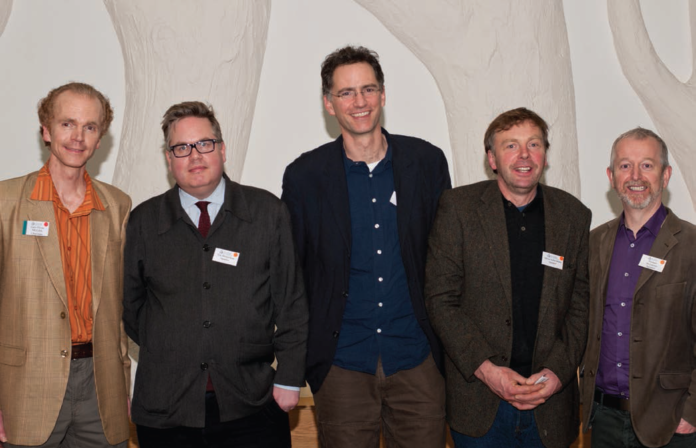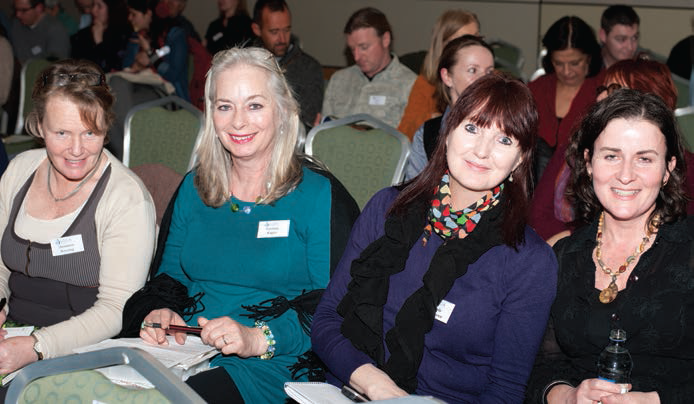

Renowned garden writer and plantswomen Helen Rock strips away the layers of the recent GLDA design seminar to reveal some inspiring insights
For nearly 20 years, the annual seminars of the Garden & Landscape Designers Association have been leading the fi eld. Early each spring, during good times and bad, the hardy perennials of the GLDA have strived to bring us reputable speakers from home and abroad, to talk of new ideas and current thinking on garden design, horticulture and landscape. This year’s gathering was refreshing and wonderfully stimulating after the winter. Held in the Crowne Plaza hotel at the sadly under-planted old Santry Demesne in demure Dublin 9, the place was hopping with horticultural types, drawn from every strand of the trade. And the good news widely heard was that business – if not exactly booming – is making good again.
The subject of the seminar was space and the way you might look at it, and it at you, the way you see space and deal with it in the context of garden and landscape. Oliver Schurmann of Mt Venus Nursery spoke first, keeping his cool admirably when the batch of images to go with the first chunk of his talk refused to show up on the screen. A consummate plantsman and multi-award-winning designer, Oliver’s passion carried him on its wings and led us into interesting realms of journeying, of planting, of art, line, colour form and new landscapes created from old industrial architecture.
‘Gardens can change and improve all our lives,’ he said. ‘We can learn how to create spaces that are soothing, that can change us and make us feel small again, part of a big world where the garden is looking at us. It is very relaxing. I only do what I like in a client’s garden. I tell them that I can’t do certain things, insert certain lines and colours that disturb my taste.’ He spoke of creating levels, of making paths to draw the eye, of the ha-ha effect and the valley effect, of seeing the garden from a frog pond and of a false perspective. It was a masterclass in garden design, packed into what seemed too short a time.
JAKE
HOBSON
Jake Hobson is a sculptor who works with gardens rather than conventional art materials. He seems to enjoy his work hugely. As well as doing specialist cloud and other topiary pruning for private clients, he and his Japanese wife run a company called Niwaki, that imports desirable Japanese tools and garden equipment.
After studying at the Slade in London and with no real interest in gardening at the time, he first travelled to Japan on a bursary, to study the ‘cultural aspects of the cherry blossom season’. But while the blossom was lovely, Jake says he was ‘utterly blown away’ by the beautifully sculpted trees he saw in the Japanese temple gardens. He went back almost immediately, got a job in a traditional tree nursery in Osaka and began to learn the art of niwaki: cultivating, shaping and pruning garden trees and making them fit the space available to them. He loves pruning and does it fast, creating new shapes, new spaces, places and views in even the smallest garden by the judicious application of his craft, using a hand shear and, like the Japanese, a much wider variety of shrubs and trees than the more usual yew, box, privet and Leyland cypress.
Interestingly, he said that you’ll never see a potted plant for sale in a Japanese nursery. They just don’t do pots (nor root pruning, nor feeding apparently). Instead, everything is root balled in the earth and heeled in, with the bigger trees heeled in special hollows for shelter. That sounds to me an eco-cool and less expensive method of production, but please correct me if I’m wrong. Jake Hobson is the author of The Art of Creative Pruning (Timber Press, £25), a refreshing and detailed guide to pruning which is full of practical lessons and steeped in Japanese method, though by no means a slave to all its traditions.
FOOD FOR
THOUGHT
We broke for lunch: some people were ravenous and fell on their food, while others followed landscape architect Feargas McGarvey out the door and over the road to give them a brief tour of the Demesne and the works done by his fi rm, Mitchell & Associates, after the development. (Btw, there’s a golden opportunity to plant a small native woodland there, where it is most scrubby, underplanted and neglected.) The mood over lunch was optimistic: the designers are busy and there are quite a few big jobs happening, for discreet clients who didn’t go broke in the bust and are starting to spend again.

FEARGUS
MCGARVEY
The same Feargus McGarvey was also the third of the day’s four speakers, slotted into the notoriously sleepy post-prandial slot. A veteran of several landmark projects, including overseeing the Martha Schwartz installation at Grand Canal Square and some tricky landscaping and planting around the visitor centre and car park at the Giants’ Causeway, his delivery was nothing if not Zen, opening up several new avenues for exploration as he talked calmly of ways of seeing, of observing and spatial relationships. He spoke of how his training as a landscape architect was embedded with sustainability before it was an issue, about the importance of making intimate spaces (always with seats) and of designing without ego.
“Training as a landscape architect was embedded with sustainability before it was an issue, about the importance of making intimate spaces (always with seats) and of designing without ego”
TIM
RICHARDSON
Being the last speaker of the day is not an easy slot, especially when the day is running well over time and people have to leave in the middle to catch trains or children or whatever, but Tim Richardson, the English garden writer and director of the burgeoning Chelsea Fringe festival, was unflappable and wooed his audience with funny stories and anecdotes, strong and slightly scandalous views of famous designers and their design mistakes, with his immense grasp of gardening history and not least by the sensational series of images he used, all taken by leading garden photographer and all-round nice man, Andrew Lawson.
The former gardens editor for Country Life magazine, who’s been in the wars lately for describing many members of the Society of Garden Designers as ‘the ladies who lunch’ and don’t do much else, has no truck with the division between designers and landscape designers or architects. He also spoke of changing trends, of how for example, shrubs went out of fashion with the new perennial planting but are creeping back in now. And he really wants us to start an Irish Chelsea Fringe here, as they are now doing in Belfast. There wasn’t a huge enthusiasm for this idea of a not for profi t festival, and besides, we couldn’t really do a Chelsea Fringe here when we have Bloom. We’d have to call it something else. ✽
  HELEN ROCK is a passionate gardener, author and regular contributor in the national press on garden-related issues. |







